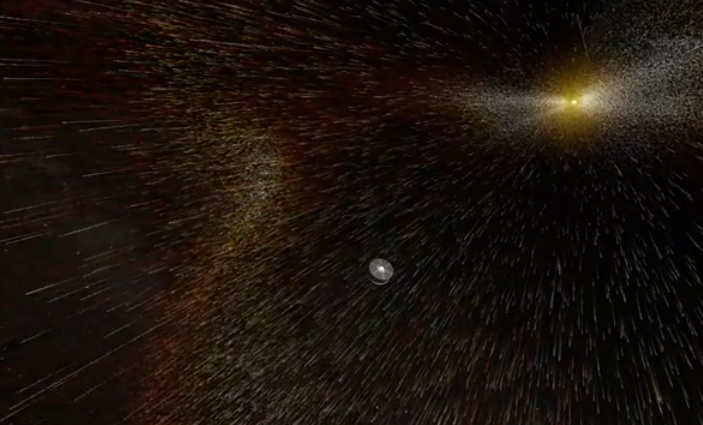Mars rover Curiosity experienced and measured X2-class solar flare radiation storm

On January 27, 2012, Curiosity’s spacecraft was hit by the most intense solar radiation storm since 2005. The event began when sunspot AR1402 produced an X2-class solar flare. (On the “Richter Scale of Solar Flares”, X-flares are the most powerful kind.) The explosion accelerated a fusillade of protons and electrons to nearly light speed; these subatomic bullets were guided by the sun’s magnetic field almost directly toward Curiosity. Researchers say it’s all part of Curiosity’s job as a ‘stunt double’ for human astronauts as this mini-Cooper-sized rover is playing the role of stunt double for NASA astronauts.
When the particles hit the outer walls of the spacecraft, they shattered other atoms and molecules in their path, producing a secondary spray of radiation that Curiosity both absorbed and measured.
“Curiosity is riding to Mars in the belly of a spacecraft, where an astronaut would be,” explains Don Hassler of the Southwest Research Institute in Boulder, Colorado. “This means the rover experiences deep-space radiation storms in the same way that a real astronaut would.” “Curiosity was in no danger,” says Hassler. “In fact, we intended all along for the rover to experience these storms en route to Mars.”

Unlike previous Mars rovers, Curiosity is equipped with a Radiation Assessment Detector. The instrument, nicknamed “RAD,” counts cosmic rays, neutrons, protons and other particles over a wide range of biologically-interesting energies. RAD’s prime mission is to investigate the radiation environment on the surface of Mars, but researchers have turned it on early so that it can also probe the radiation environment on the way to Mars as well.
RAD’s primary science objectives are to:
- Characterize the energetic particle spectrum at the surface of Mars
- Determine the radiation dose for humans on the surface of Mars
- Enable validation of Mars atmospheric transmission models and radiation transport codes
- Provide input to the determination of the radiation hazard and mutagenic influences to life, past and present, at and beneath the Martian surface
- Provide input to the determination of the chemical and isotopic effects of energetic particles on the Martian surface and atmosphere


Curiosity’s location inside the spacecraft is key to the experiment.
“We have a pretty good idea what the radiation environment is like outside,” says Hassler, who is the principal investigator for RAD. “Inside the spacecraft, however, is still a mystery.”
Even supercomputers have trouble calculating exactly what happens when high-energy cosmic rays and solar energetic particles hit the walls of a spacecraft. One particle hits another; fragments fly; the fragments themselves crash into other molecules.
“It’s very complicated. Mars rover Curiosity is giving us a chance to actually measure what happens.”
In the aftermath of the Jan. 27thX-flare, RAD detected a surge of particles several times more numerous than the usual cosmic ray counts. Hassler’s team is still analyzing the data to understand what it is telling them about the response of the spacecraft to the storm.
More X-flares will help by adding to the data set. Hassler expects the sun to cooperate, because the solar cycle is trending upward toward a maximum expected in early 2013.
As of February 2012, “we still have 6 months to go before we reach Mars. That’s plenty of time for more solar storms.”
Source: science.nasa.gov
Featured image: NASA (movie screenshot)

http://solarflareprepare.com/todays-links-february-26-2012/